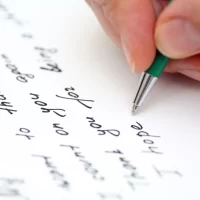Choose the Right Tools
Having the appropriate writing tools is essential in maintaining good handwriting. Irrespective of whether you prefer a pencil or a pen, you should seek to find a writing instrument with the right balance and comfort for your hand. Different tools result in changes of writing response, due to factors like tip smoothness, ink flow and pen weight. Thus, it is necessary to explore multiple options to identify the tool that best matches your writing style.
People often overlook the significance of paper quality in handwriting, but the connection between tool and paper also plays a vital role in writing clarity. The texture and thickness of your paper can affect how your writing instrument moves across its surface, allowing for a smoother or more resistant flow. Additionally, lined or graph paper can provide guidelines aiding in the consistency of letter and word spacing, which also improves handwriting. Therefore, choosing the right tools extends beyond just the pen or pencil you use-it also includes the surface you write on.
Focus on Proper Grip
The manner in which you hold your pen or pencil directly influences the legibility and fluency of your handwriting. Maintaining a proper grip is critical as it plays a substantial role in controlling the movement and direction of the pen over the surface. Proper grip will not only improve the precision of your handwriting but also increase the speed, preventing hand fatigue during lengthy writing sessions.
Correct positioning of the hand can make writing smoother and more effortless. The recommended grip is known as the “tripod grip”, where the writing tool is held between the thumb and the index finger, with the pen resting on the middle finger. This grip provides optimum control and stability. It’s essential to remember that the grip should be gentle and relaxed to allow flexibility and ease of movement. Keep in mind that a too-tight grip could lead to discomfort and hinder the fluidity of your writing.
Control Pressure and Relaxation
Governing the amount of force exerted on the paper while writing is crucial for legibility as well as for comfort. If the pressure is too light, the writing may become illegible, and if it’s too heavy, it could result in strain and discomfort, potentially leading to conditions like writer’s cramp. Developing a balanced squeeze not only promotes a healthy writing habit but can also result in a more aesthetically pleasing handwriting style.
Alongside maintaining control over pressure, having a relaxed grip is also equally important. Over gripping or holding the writing instrument too tight could lead to muscle fatigue and discomfort, which may eventually impact the quality of handwriting negatively. Relaxation in the hand muscles while writing allows for smoother, more fluid movements, which is key to developing a neat, even and legible handwriting style. It also increases the time one can write without feeling strain or fatigue.
Practice Writing Speed
While many consider penmanship a slow and careful process, the pace at which one writes significantly influences the overall handwriting quality. Balancing precision with speed often poses a challenge, especially when expressing complex thoughts or when under time pressure. This necessitates the need to practice writing swiftly without compromising legibility.
Techniques to enhance writing speed can vary greatly among individuals. Some writers may find it beneficial to work on improving their fine motor skills or aim for more fluid hand movements. Engaging in exercises such as fast-paced word association games, timed writing tasks or repeating loops and swirls can offer significant benefits. Other writers may make strides by focusing on efficiency, honing the ability to articulate their thoughts promptly and then translate these onto paper in a quick and clear fashion. Regardless of the chosen approach, the key lies in consistent practice, which will gradually lead to improvements in both writing speed and overall handwriting quality.
Consistent Practice and Patience
Understanding the art of handwriting is no different than acquiring any other skill. It’s a process that requires relentless practice and a significant amount of patience. Just like learning to play a musical instrument or mastering a complex recipe, it demands consistent effort, dedication, and time. Here, patience and perseverance are a writer’s best friend, guiding them steadily toward their goal of achieving a beautiful handwriting style.
In order to continually improve your handwriting, it is advisable to establish regular practice sessions. Daily drills of the alphabet and sentences, focusing on letter shapes and spacing, may feel mundane, but they slowly and surely lead to improved writing skills. Meanwhile, a healthy dose of patience is needed when the progress seems slow. Remember, the journey to good handwriting isn’t a sprint, but rather a marathon. So, stay the course, don’t rush your growth, and over time you are sure to see the fruits of your labor.
Benefits of Having a Good Handwriting Style:
Good handwriting style offers numerous benefits, one of the key ones being enhanced readability. With neat and structured handwriting, individuals find your text easier to understand and read, reducing misunderstandings and mistakes caused by indecipherable or sloppy handwriting. In essence, better handwriting significantly reduces the cognitive load on the reader’s part, as they spend less time trying to decipher the text, which in turn, enhances the overall communication process.
Additionally, a good handwriting style also adds a sense of professional appearance to your work. It’s often received as a reflection of meticulousness and attention to detail, qualities that are highly valued in professional environments. This can benefit your professional life, providing an edge in situations where clear, concise, and neat communication counts. Moreover, improved handwriting has shown to increase focus and concentration by promoting better neuronal connections, hence nurturing cognitive development. Outstanding handwriting is not just about aesthetics, but also about cognitive health and effective communication.
Enhanced Readability
Handwriting quality significantly influences the degree to which written content can be easily read and understood. By possessing a good handwriting style, the legibility of any written text improves, leading to what is known as enhanced readability. This term refers to the ease with which a reader can navigate through text, swiftly understanding each word, sentence, and overall written thought. Indeed, a neat, distinct penmanship excludes any room for misinterpretations or misunderstandings that would otherwise be caused by illegible or confusing handwriting.
Furthermore, when your handwriting is clear and well-structured, it requires less cognitive effort to interpret and understand by the reader. This results in enhanced readability as the brain is capable of processing, assimilating, and recalling the information more efficiently. In contexts such as education or professional work where comprehension matters, legible handwriting reduces the time taken by the reader to decipher the written content and directly increases their absorption of the information. This certainly underlines the significance of having a good handwriting style.
Professional Appearance
Having good handwriting not only imparts clarity but also adds a dash of professional appeal to your written communication. In professional settings, the way your handwriting appears can often be a deciding factor in establishing your credibility. For example, if you are filling out a form or signing a document, the clarity and neatness of your script can leave a positive impact, showcasing your attention to detail and meticulousness.
The aesthetics of your penmanship, believe it or not, can also convey a strong image of self-discipline and professionalism. Scruffy or illegible notation can create an impression of carelessness, or a lack of effort. But when every letter is shaped with precision and consistency, it showcases your dedication to leaving no stone unturned in your work. While most of our communication today is digital, there are instances where good old fashioned writing cannot be replaced. So, having good handwriting is not an obsolete skill, rather it’s a powerful tool that enhances your professional image.
Improved Communication
Handwriting plays a considerable role in fostering better communication. An individual’s ability to express ideas, information, or thoughts is significantly heightened by good handwriting. It’s simply because clear and legible handwriting can easily be comprehended without requiring additional effort or time to decode. We can’t ignore the assurance of decreased misinterpretation and errors when reading ideas noted down with good handwriting. Hence, it’s evident that legible handwriting acts as the silent envoy of effective communication.
Moreover, in our current era, where digital communication is prevalent, the handwritten messages are fading gradually. However, the importance of handwritten notes or letters is still intact due to their personal touch. Having a clear handwriting style even adds a distinctive persona to these writings. That’s where possessing good handwriting serves as a powerful tool to convey your ideas unmistakably. After all, in any form of communication, the clearer the message, the more efficient it is.
Increased Focus and Concentration
Paying attention to every curve and line as we write promotes concentration and hones our focus. This meticulous process can heighten one’s mental alertness and memory as the act of handwriting, compared to typing, is more engaging and complex. Handwriting calls upon intricate motor skills and hand-eye coordination, which tap into various cognitive faculties. It is an exercise that keeps our brain fit and agile, helping us to maintain and even increase our attention span.
Often falling under the radar, handwriting is a form of meditation as well, providing a source of relaxation by concentrating our minds on a single activity. It waves a calming effect on our nerves, assisting in the reduction of stress and anxiety. As a result, it enhances our ability to concentrate on other tasks. The repetitive and rhythmic nature of handwriting can act as a form of mindfulness practice, uniting the mind and body in the moment. This unity can lead to greater focus, an improved ability to recall information, and better overall mental health.



























